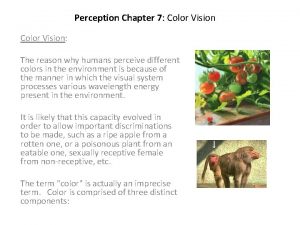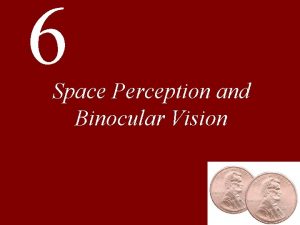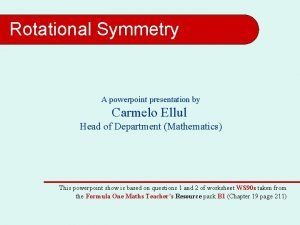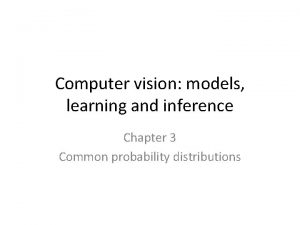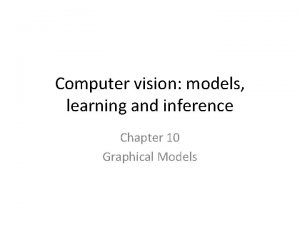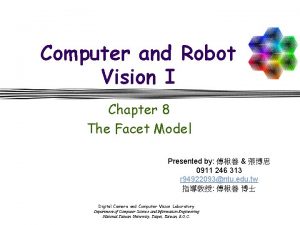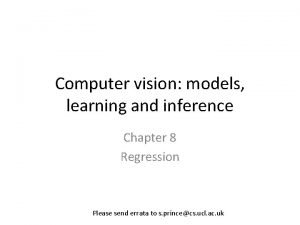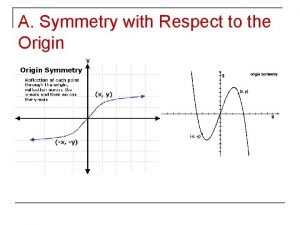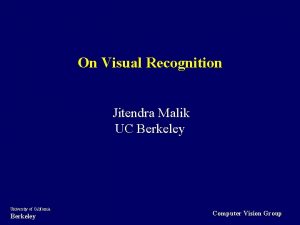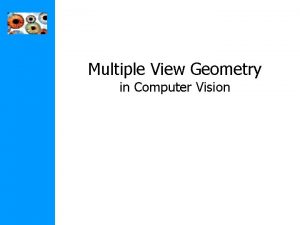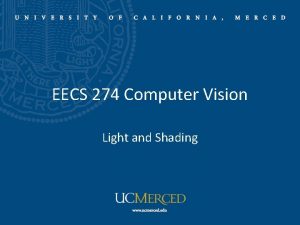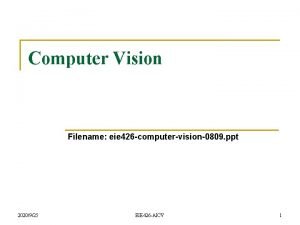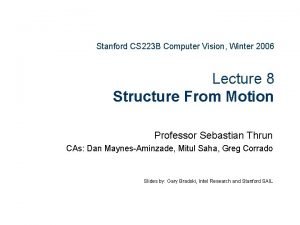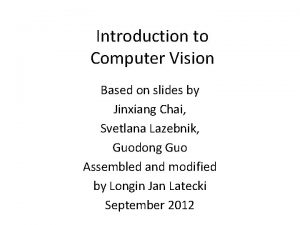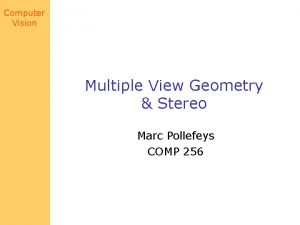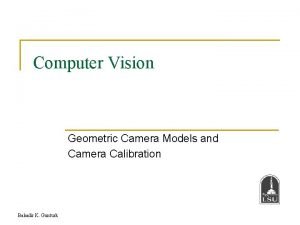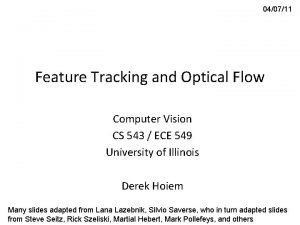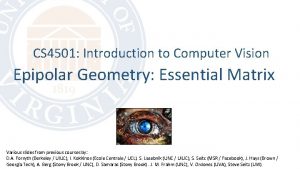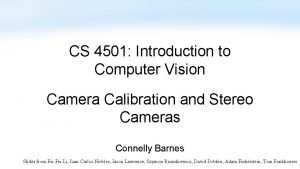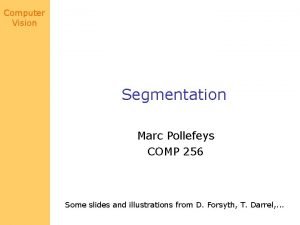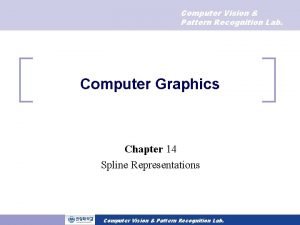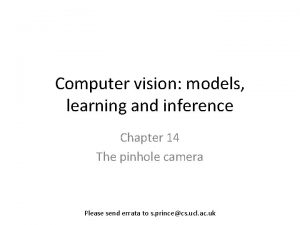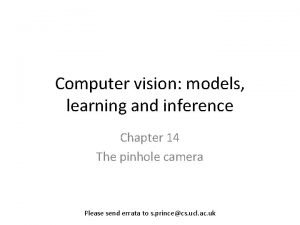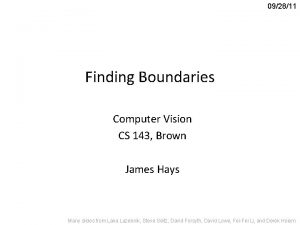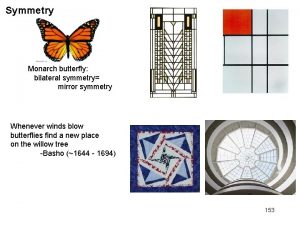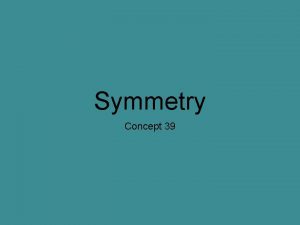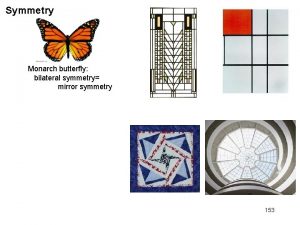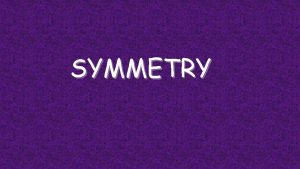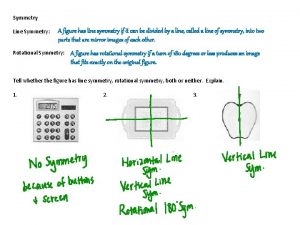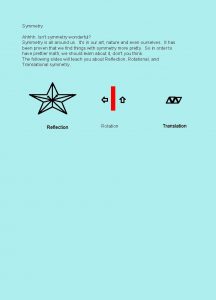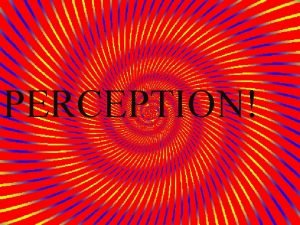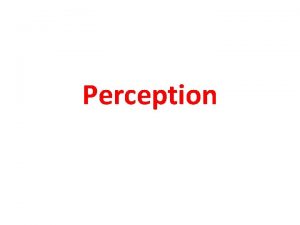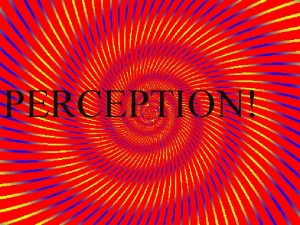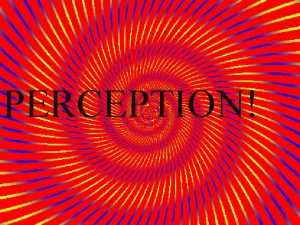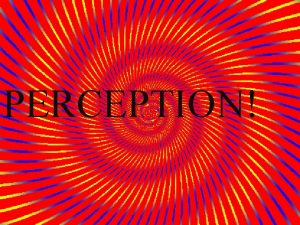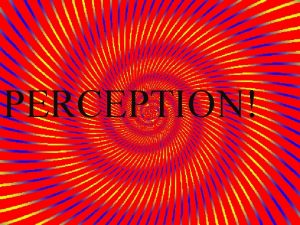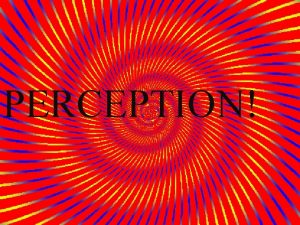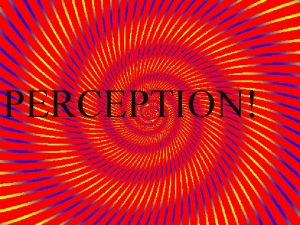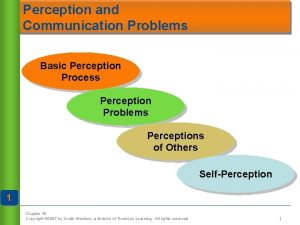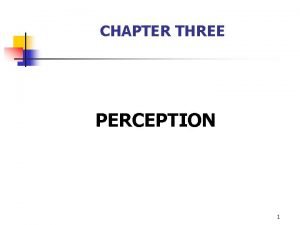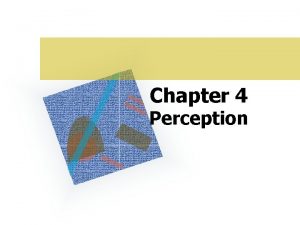Symmetry Definitions and Perception of Symmetry Computer Vision












































- Slides: 44

Symmetry Definitions and Perception of Symmetry Computer Vision Seminar – Symmetry Presented by: Dado Ofir Haifa university

Symmetry - Out. Line. Definitions. Motivation. Type of symmetry. Symmetry groups. Perception of Symmetry. Summary • • •

Symmetry Definitions: The concise Oxford Dictionary says " 1. (Beauty resulting from) right proportion between the parts of the body or any whole, balance, harmony, keeping. 2. Such structure as allows of an objects being divided by a point or a line or plane or radiating lines or planes into two or more parts exactly similar in size and shape and in position relative to the dividing point, ect. repetition of exactly similar parts facing each other or a centre, . . " • •

Symmetry in our life: • Architecture Sculptures Painting Nature – –

Type of symmetry There is 4 type of symmetry: • Rotation Translation Reflection Glide Reflection – –

Type of symmetry - Rotation A figure has rotational symmetry when it can be • rotated less than 360° around a central point, or and still match the original figure point of rotation : Example •

Type of symmetry - Translation Move it without rotating or reflecting it • Every translation has a direction and a distance • Before translation After translation

Type of symmetry - Reflection • Reflection symmetry is sometimes called "mirror" or "flip" symmetry. It's easy to see why A butterfly (see below) may have reflection symmetry because one side is a mirror image of the other. • Notice that a vertical line down the center of the butterfly's body serves as what is called the "line of symmetry. "

Type of symmetry - Reflection The letter A has reflection symmetry similar to the butterfly.

Type of symmetry - Glide Reflection Involves more than one step Combination of a reflection and a translation along the direction of the mirror line • •

Symmetry groups- linear groups Cyclic group • Dyhedral group •

Symmetry groups- linear groups : Example dyhedral group • This is a D 12. Patterns like these often appear in stained glass windows. This is a D 3 group. It contains three reflections and a rotation of order 3. This is a D 1 group. All dihedral groups contain a reflection. This group contains 12 reflections and a rotation of order 12 It sort of looks like a hubcap, doesn't it? Some people call these wheel patterns.

Symmetry groups- linear groups : Example Cyclic group • This is an example of C 3. It is This is C 1. No reflections and no rotations somewhat more interesting than C 1. This is an example of C 12 other than the trivial rotation There is a rotation of order three.

Symmetry groups- linear groups Perhaps the most simple example of the two • groups is tripod. If we want to eliminate the reflective symmetry , all we have to do is add a . little flags on its arms

Symmetry groups- Frieze groups are subgroups of isometrics of Euclidian plane. They are restricted to some obvious rules: Only one translation is allowed. 1 Only two reflections are allowed – one to the line in . 2 the center of the pattern and the second vertical to the pattern Only rotations of second order are allowed. 3 •

Symmetry groups- Frieze groups Examples • This type has only a translation. This type has a translation and a vertical mirror. This type has a translation and a rotation.

Symmetry groups- Frieze groups Examples • This type has a translation and a horizontal mirror. This type has a translation and a reflection.

Symmetry groups- Frieze groups Examples • This type has two vertical mirrors and a glide reflection. This last type has two vertical mirrors and a horizontal mirror. There also rotations in this group.

Symmetry groups- Platonic solids : Definition • Platonic solids are perfectly regular solids with the following conditions: all sides are equal and all angles are the same and all faces are identical. In each corner of such a solid the same number of surfaces collide. Only five Platonic solids exist: tetrahedron , hexahedron, octahedron, dodecahedron and icosahedron

Symmetry groups- Platonic solids The solids and their regularities were discovered • by the Pythagoreans and were called originally Pythagorean solids. The Greek philosopher Plato described the solids in detail later in his book "Timaeus" and assigned the items to the Platonic conception of the world, hence today they are ". well-known under the name "Platonic Solids

Symmetry groups- Platonic solids • The tetrahedron is bounded by four equilateral triangles. It has the smallest volume for its surface and represents the property of dryness. It corresponds to fire. • The hexahedron is bounded by six squares. The hexadedron, standing firmly on its base, corresponds to the stable earth.

Symmetry groups- Platonic solids The octahedron is bounded by eight equilateral • triangles. It rotates freely when held by two opposite vertices and corresponds to air. • The dodecahedron is bounded by twelve equilateral pentagons. It corresponds to the universe because the zodiac has twelve signs corresponding to the twelve faces of the dodecahedron.

Symmetry groups- Platonic solids The icosahedron is bounded by • twenty equilateral triangles. It has the largest volume for its surface area and represents the property of wetness. The icosahedron. corresponds to water

Symmetry groups- rotation groups Every object has its rotation symmetry. This symmetry • can be defined by rotation axes and rotation operators. : Let’s understand it over an example

Symmetry groups- rotation groups The prism we saw in the example • can fit into the box in 6 different ways. So, we can define our rotation axes and rotation operators. As we can see there are 4 rotation axes and 6 operators – Ca, Cb, Cc, Cd 1, Cd 2, E . while E is identity operator

Symmetry groups- rotation groups In the same way we defined rotation for prism we • can define it for each object we choose. For example cube has 24 ways to fit a box so it’s . rotation symmetry is bigger

Perception of Symmetry- Some psychological observations “Psychologically speaking, symmetry is not relatively superficial characteristic of pattern and object like, say, color but that it is an essential characteristic which affects profoundly both their immediate perception and their memorability” (Corballis, 1963; Corballis and Beale, 1976, 1983)

Perception of Symmetry- Some psychological observations over time there was a lot of study dealing with the • perception of symmetry. HOWE - “the dot test” – Short exposure • Long exposure • Goodness and Geometricity of symmetry – HOWE, SZILAGYI and BAIRD – “ the pleasant test “ • Conduct a series of test in which the subject was requested to – grade/create an object by criteria – balance, pleasingness, goodness, simplicity, and dispersion. Symmetry had a direct effect on all except dispersion. –

Perception of Symmetry- Some psychological observations SZILAGYI and BAIRD found that most of the subjects • created asymmetric figure with vertical symmetry. GOLDMEIER – “ the deformed test ” • Found that deformed object which leave the symmetry intact are – more similar to the original than minimal asymmetrically deformed object.

Perception of Symmetry- Some psychological observations Orientation of symmetry •

Perception of Symmetry- Some psychological observations Orientation of symmetry – explanation : • In order to process it as possible, the visual apparatus resorts to legerdemain and since no vertical symmetry in the plane of the figure is observable it resorts to an alternative interpretation and creates a 3 D figure which is symmetrical

Perception of Symmetry- Some psychological observations Vertical Symmetry • A collection of experiments show that vertical – symmetry is the most salient and easily perceived. GOLDMEIER test –deformed object. •

Perception of Symmetry- Some psychological observations Vertical Symmetry • ROYER measured RT for detection of symmetry and – found that the RT to detect vertical symmetry is faster then the RT of horizontal symmetry.

Perception of Symmetry- Some psychological observations The human face is approximately, symmetrical • . the difference are usually unnoticed ? What happen when we mirror our face • Original picture Duplicate the right side Duplicate the left side

Perception of Symmetry- Some psychological observations When we mirror the face we get 2 new faces one of – which looks much more similar to the original face than the other. The two sides of the face –

Perception of Symmetry- Some psychological observations Mental Rotation vs Template models • Template model – For each angle of symmetry axis there is a template or a • simple mechanism which detects the symmetry in a pattern. Mental rotation model – A single mechanism exists which detects the symmetry • (specifically detects vertical symmetry). All other mirror symmetries are detected by rotation- to align it symmetry axis to the vertical axis (assumed to be linear in time ).

Perception of Symmetry- Some psychological observations More of GOLDMEIER experiments •

Perception of Symmetry- Some psychological observations Support for the mental Rotation Model • CORBALLS & ROLAND – They used a random cluster of six dots which were • repeated or mirrored a round an axis –which was tilted at 0, 45, 90 or 135 d The subject were asked to detect symmetry pattern. •

Perception of Symmetry- Some psychological observations CORBALLS & ROLAND – Result showed that shorter RT is when •

Perception of Symmetry- Some psychological observations Physiological and anatomical support Symmetry • processing It is well known that the human visual system is – bilaterally symmetric. Does it influence visual symmetry perception? The coordinate system is aligned with the retinal coordinate • system. The coordinate system is aligned with the gravitation • coordinate system. JULESZ suggested that the underlying symmetry anatomy • of the visual system is the basis for high frequency symmetry detection.

Perception of Symmetry- Some psychological observations ? Symmetry inherent or learned • Evolution – Eyes location – symmetry stimulus. Behavioural aspects – when detecting animal face was a matter of survival. The natural evolve of the symmetry detection system. Conclusion – symmetry is unherent. is it? • •

Perception of Symmetry- Some psychological observations ? Symmetry inherent or learned • Evolution – The mental rotation model and other experiments, show • the robustness of symmetry perception and promote the idea that learning is part of the symetry detection mechanism. The enatiomorphic confusions • b-d –

Summary Symmetry is in our life. • There are 4 fundamental type of symmetry. • Symmetry group • Linear group. Frieze groups. Platonic solids. rotation groups. – – psychological observations. • Experiments. – study's. –

References Hagit Zabrodsky Hel-Or. symmetry – a review. technical report 90 -16. may 1990 jerusalem-u. Perception of Symmetry- Some psychological observations. Jan B. Deregowski. “Symmetry” Hermann Weyl http: //www. ensc. sfu. ca/people/grad/brassard/personal/THESIS/node 45. html http: //www-history. mcs. st-and. ac. uk/~john/geometry/Lectures/L 8. html http: //home. hccnet. nl/jc. kuiper/optillus. htm http: //www. education. gov. il/tochniyot_limudim/math/shikuf. htm • •
 Structured light
Structured light Chapter 7 vision and perception
Chapter 7 vision and perception Crossed disparity
Crossed disparity Horizontal e vertical
Horizontal e vertical Symmetry elements ppt
Symmetry elements ppt Computer vision models learning and inference
Computer vision models learning and inference Mathematical foundations of computer graphics and vision
Mathematical foundations of computer graphics and vision Computer vision: models, learning, and inference
Computer vision: models, learning, and inference Computer vision: models, learning, and inference pdf
Computer vision: models, learning, and inference pdf Computer and robot vision
Computer and robot vision Computer vision: models, learning, and inference
Computer vision: models, learning, and inference Function symmetric with respect to the origin
Function symmetric with respect to the origin 16-385 cmu
16-385 cmu Kalman filter computer vision
Kalman filter computer vision Svd computer vision
Svd computer vision Berkeley computer vision
Berkeley computer vision Multiple view geometry in computer vision.
Multiple view geometry in computer vision. Font detector
Font detector Radiometry in computer vision
Radiometry in computer vision Linear algebra for computer vision
Linear algebra for computer vision Impoverished motion examples
Impoverished motion examples Computer vision ppt
Computer vision ppt Computer vision stanford
Computer vision stanford Multiple view geometry in computer vision
Multiple view geometry in computer vision Azure cognitive services python
Azure cognitive services python Computer vision slides
Computer vision slides Ilsvrc-2012
Ilsvrc-2012 Computer vision final exam
Computer vision final exam Computer vision sift
Computer vision sift Multiple view geometry in computer vision
Multiple view geometry in computer vision Camera models in computer vision
Camera models in computer vision Computer
Computer Computer vision vs nlp
Computer vision vs nlp Epipolar geometry computer vision
Epipolar geometry computer vision Zed camera calibration
Zed camera calibration Computer vision
Computer vision Computer vision
Computer vision Computer vision
Computer vision Computer vision
Computer vision Computer vision
Computer vision Computer vision
Computer vision Fourier transform computer vision
Fourier transform computer vision Image formation computer vision
Image formation computer vision Computer vision brown
Computer vision brown Computer vision brown
Computer vision brown

